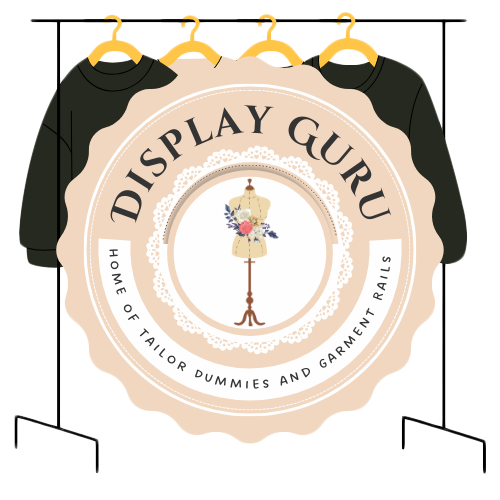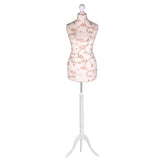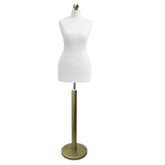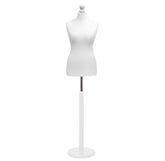Choosing Mannequin Heads for Wigs a Complete Guide
Far more than just a simple stand, a mannequin head for wigs is the silent partner in the entire lifecycle of a wig. Think of it as the essential canvas for everything—from precision styling and colouring to routine maintenance and secure storage. For professionals, it's non-negotiable; for enthusiasts, it's a total game-changer.
Why Your Choice of Wig Head Matters
Imagine a tailor trying to create a bespoke suit without a dress form. It sounds impossible, right? A high-quality mannequin head serves the exact same purpose for your wig. Just as a tailor relies on an adjustable mannequin for sewing your ultimate fitting guide, a wig stylist needs a properly sized head to cut, style, and treat a wig with any degree of accuracy. Without it, you’re essentially working blind, guessing how the final style will frame a face or how the layers will naturally fall.
This becomes crystal clear when you tackle more intricate tasks. Trying to colour roots, trim a fringe, or craft a complex updo while a wig is lying flat on a table isn't just difficult—it’s a recipe for uneven, disappointing results. A stable mannequin head gives you a realistic, three-dimensional foundation. It lets you work with both hands and see your creation from every angle, ensuring symmetry, precision, and a professional finish every single time.
Protecting Your Investment
A good wig is a real investment, and the right mannequin head is its best insurance policy. Storing a wig improperly, like stuffing it in a bag or leaving it on a flat surface, can crush the cap and cause it to lose its shape. This leads to a poor fit and a tangled mess of fibres. A head that mirrors the wig's cap size is crucial for preserving its structure, preventing it from stretching or becoming distorted over time.
This protective role is vital for getting the most out of your wigs. How you store and maintain them directly impacts how long they keep their lustre and style. This is more important than ever, with the UK hair wigs and extensions market valued at around USD 342.3 million in 2021 and projected to hit nearly USD 694.2 million by 2030. That's a lot of people needing reliable tools to care for their wigs. For a deeper dive into this growing industry, you can check out this detailed market analysis report.
The Foundation of Wig Artistry
At the end of the day, choosing the correct mannequin head is the most important first step toward mastering the art of wigs. It transforms the process from a frustrating guessing game into a controlled, creative practice.
Using the right mannequin head completely changes how you interact with a wig. It provides the stability and realistic form needed to practise advanced techniques, ensuring the style you create on the head is the style you get when it's worn.
Whether you're a seasoned stylist perfecting a custom piece or a wig lover looking after your personal collection, the benefits are undeniable:
- Precision Styling: Achieve symmetrical cuts, even colour, and perfectly balanced styles.
- Enhanced Durability: Protect the delicate cap construction and prevent fibre damage.
- Realistic Visualisation: See exactly how a style will look on a human-like form before it’s worn.
- Efficient Workflow: Free up both hands for more complex and creative work.
By getting these fundamentals right, you're setting yourself up for success, ensuring every wig you handle looks flawless and lasts for years to come.
Selecting the Right Material for Your Wig Head
Choosing the material for your mannequin head isn't just some minor detail—it fundamentally dictates what you can actually do with your wig. The material determines its purpose, how long it'll last, and how you'll interact with it during styling. It’s the difference between a simple storage stand and a proper professional styling tool.
Think of it like this: you wouldn't use a delicate porcelain plate to chop vegetables. In the same way, the material of your wig head must match the task at hand. Picking the wrong one can lead to frustration, potential damage to your wig, and results that just don't look right. This choice is your first real step towards mastering wig care and styling.
Styrofoam: The Entry-Level Option
Styrofoam (or polystyrene) heads are often the first type people come across. They're lightweight, easy to find, and incredibly cheap, which makes them a go-to for beginners or for simple storage. If you just need a basic form to keep your wig's shape between wears or while it air-dries, a styrofoam head does the job perfectly well.
However, you'll run into its limitations pretty quickly. Styrofoam is soft and crumbles easily, especially when you apply any pressure. While you can use T-pins, doing it repeatedly will cause the head to disintegrate, leaving you with little to no grip. They just don't have the weight or stability needed for any serious styling, brushing, or cutting.
Canvas Block Heads: The Professional Standard
For anyone serious about making, styling, or maintaining wigs, the canvas block head is the undisputed industry standard. These heads are built to last, usually made from a sturdy cork or polyurethane base and covered in a durable canvas fabric. This combination is what makes them so effective.
The real magic of a canvas head is how well it takes a pin. The firm-yet-forgiving core lets you insert T-pins deeply and securely at any angle, holding the wig firmly in place without any chance of it slipping. This solid grip is absolutely essential for detailed jobs that require tension and precision.
Here's where a canvas head really shines:
- Ventilating: The meticulous process of hand-tying individual hair strands onto a lace base requires a completely stable foundation.
- Intricate Styling: Creating complex updos, braids, or using heat stylers like curling tongs demands that the wig stays perfectly still.
- Customisation: Plucking a hairline or cutting layers is precise, steady work that you can only do if the wig is securely pinned down.
The image below gives a great visual breakdown of how different mannequin heads fit into the wig care puzzle.
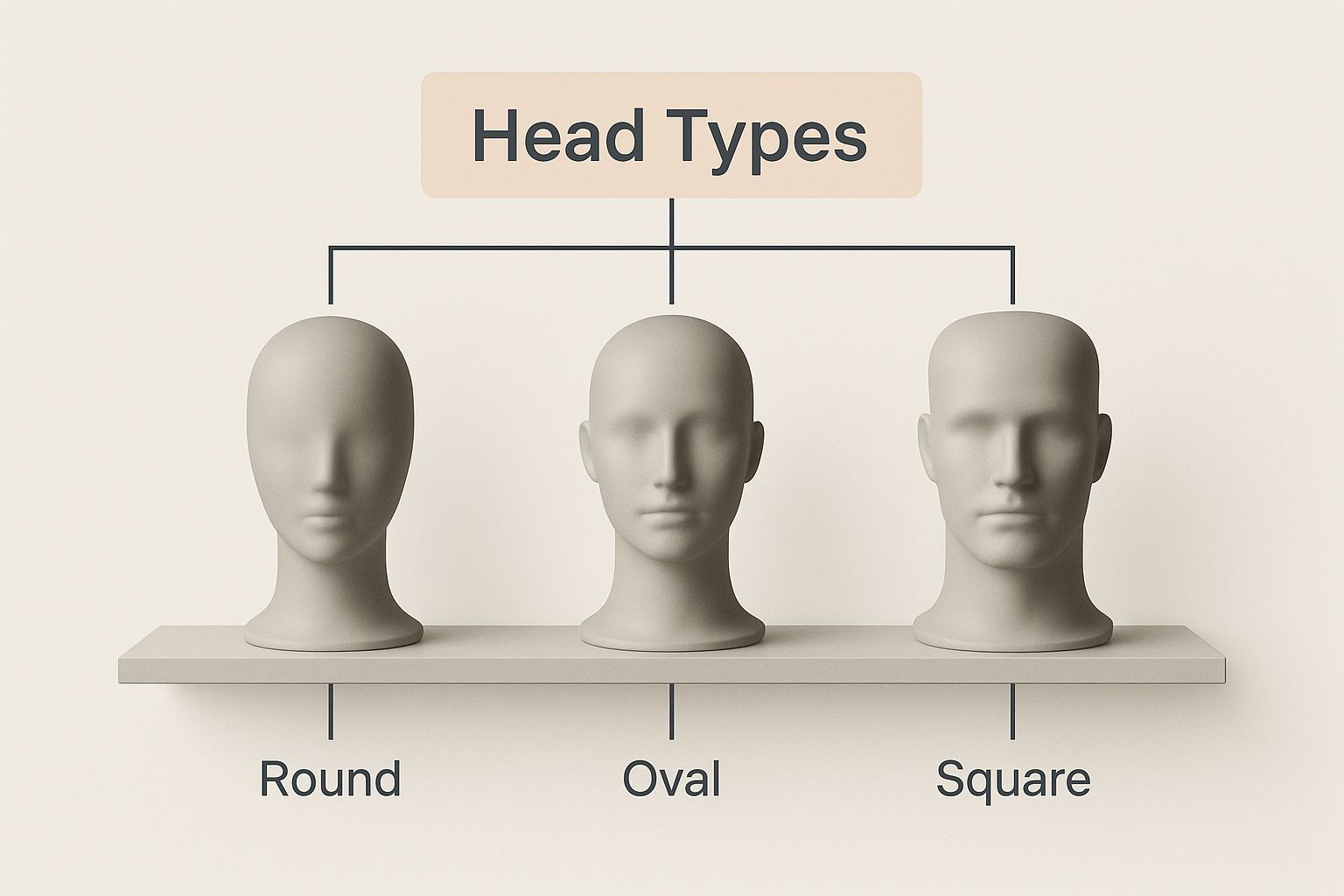
As you can see, each type is optimised for a specific function, from basic storage all the way to advanced professional work.
PVC and Silicone Heads for Display and Practice
Beyond the two mainstays of styrofoam and canvas, other materials offer unique benefits, particularly for display and specialised practice sessions.
PVC (Polyvinyl Chloride) heads are hard, durable plastic models often designed with realistic facial features, makeup, and sometimes even shoulders. Their main job is retail display. The lifelike appearance helps customers visualise how a wig will look when worn, making them a powerful sales tool for shop owners and online sellers. While they aren't great for styling because of their hard, unpinnable surface, they are excellent for showcasing your finished work. Getting the fit right is key, and you can learn more about how sizing works in our guide to mannequin measurements.
Silicone heads, on the other hand, offer a unique, slightly tacky surface that provides a non-slip grip without needing any pins. This makes them particularly useful for practising specific techniques, like applying and blending the adhesive for lace front wigs. The texture mimics skin more closely than other materials, allowing for much more realistic application practice.
To make the choice clearer, let's compare these materials side-by-side.
Comparing Mannequin Head Materials
| Material Type | Primary Use | Pin-Friendly? | Durability | Ideal For |
|---|---|---|---|---|
| Styrofoam | Basic storage, air-drying | Yes (limited use) | Low | Beginners, casual wig wearers needing simple storage. |
| Canvas Block | Professional styling, making, cutting | Yes (excellent) | High | Wig makers, stylists, and serious enthusiasts. |
| PVC Plastic | Retail display, photography | No | Very High | Shop owners, photographers, and online sellers. |
| Silicone | Technique practice (e.g., glue application) | No | Moderate | Trainees and stylists practising specific application skills. |
Ultimately, what you need the head for will guide your choice. A casual wig wearer might only ever need a simple styrofoam head. A professional stylist, however, will likely have a whole collection of canvas block heads in various sizes to work effectively.
Matching Mannequin Head Size and Shape
Think about it like this: storing a beautifully styled wig on a head that's too big or too small is like cramming a bespoke suit onto the wrong-sized dummy. It’s a recipe for disaster. The suit will stretch, lose its shape, and ultimately be ruined. The same goes for your wig.
The size and shape of your mannequin head aren't just minor details; they're absolutely fundamental. Getting it right preserves the delicate structure of the wig's cap and ensures the style looks exactly as it should when you wear it. A head that's too large will overstretch the cap, causing permanent damage and an uncomfortably tight fit. On the other hand, a head that’s too small offers no support, leaving the wig to sag and lose its form. This is why matching the head's circumference to the wig's cap size is one of the most critical steps in professional wig care.
Finding the Perfect Fit
Thankfully, sizing a mannequin head is quite straightforward. It’s the same process you’d use to measure a person's head for a wig. The goal is a perfect one-to-one match that supports the wig’s structure without putting any stress on it.
Here’s a simple guide to getting it right:
- Know Your Wig's Size: Wig caps generally come in standard sizes, measured by their circumference in inches. Common adult sizes are small (21-21.5 inches), average (22-22.5 inches), and large (23-23.5 inches). Always check your wig’s specifications first.
- Measure the Mannequin Head: When you buy a mannequin head, its circumference should be clearly listed in the product details. Professional canvas block heads are sold in specific sizes like 21", 22", or 23" for this very reason.
- Aim for an Exact Match: This isn't like buying a jumper where "close enough" will do. A 22-inch wig needs a 22-inch mannequin head. This precise fit holds the wig securely without any tension on the cap or delicate lace front.
This level of precision is more important than ever, especially as the UK's appetite for high-quality wigs continues to grow. In fact, the market for female hair pieces, wigs, and extensions is set to expand at a CAGR of 11.7% between 2021 and 2027. This boom shows a real demand for specialised products like lace front and monofilament wigs, which require careful handling. For these styles, a correctly sized mannequin head for wigs is an indispensable tool. You can find out more about this growing market and its trends.
How Head Shape Influences the Final Look
Beyond circumference, the actual shape of the mannequin head plays a huge part in how the wig will ultimately look. It helps you visualise how the style will drape and frame a face, giving you a much more accurate preview.
There are two main types to consider:
- Abstract or Egg-Shaped Heads: These are the most common, especially for canvas block heads used for styling. Their simple, generic oval shape provides a brilliant, neutral base for cutting, colouring, and ventilating because there are no facial features getting in the way.
- Realistic Heads with Facial Features: Often made from PVC or fibreglass, these heads have a defined nose, lips, and eyes. They are absolutely essential for seeing how a finished style will interact with real facial contours.
A realistic head is invaluable when you're cutting a fringe or styling face-framing layers. It allows you to see precisely where the hair will fall, eliminating guesswork and preventing costly mistakes.
You can think of it like this: an abstract head is your workshop canvas—perfect for the technical work of building and constructing the style. A realistic head, in contrast, is the gallery stand for the final presentation. For any serious stylist, having both is ideal. By paying close attention to both size and shape, you can choose a mannequin head that not only protects your investment but also helps you perfect its style with confidence.
Mastering Advanced Styling and Maintenance
This is where your mannequin head goes from being a simple stand to your most valuable styling partner. When you get the technique right, it becomes a steady, reliable assistant for everything from crafting intricate updos to carrying out essential maintenance. It's the secret to keeping your wigs looking flawless.
Think about it: a properly mounted mannequin head for wigs gives you a secure, 360-degree workspace that you just can't get any other way. With both hands free, you can work with a level of precision and control that’s simply not possible when you’re trying to juggle a wig on your lap. This stability is the bedrock of achieving professional results from the comfort of your own home.
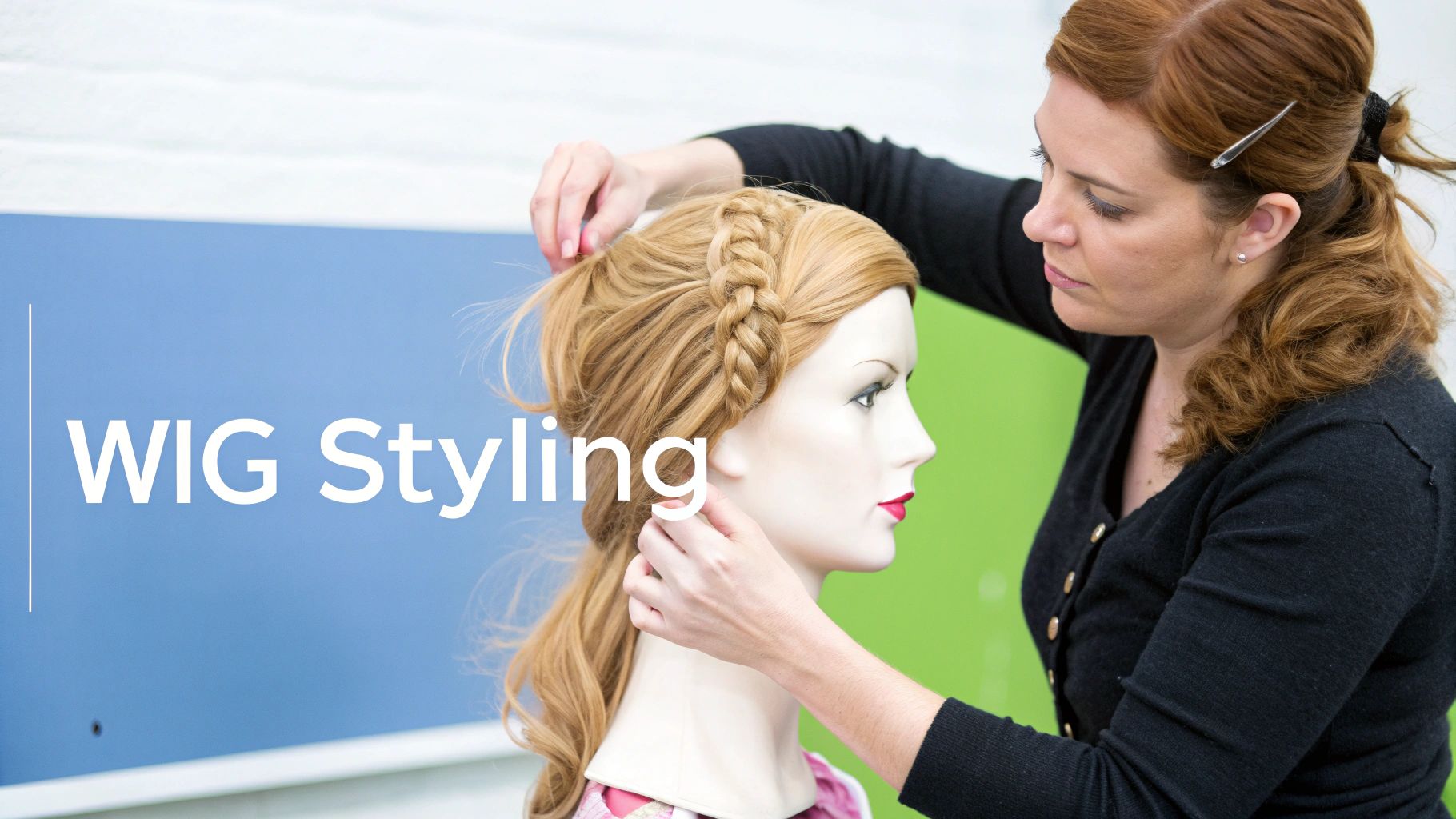
Securing Your Wig for Flawless Styling
First things first: before any styling can happen, the wig needs to be secured. This is a non-negotiable step, and it’s where a good canvas block head really proves its worth. The aim is to anchor the wig so it won't budge, but without causing any harm to the delicate lace or cap.
Your best friends for this job are T-pins. Unlike standard pins, that T-shaped top makes them a doddle to push in and pull out without snagging any precious hair fibres.
Gently pop the wig onto your correctly sized canvas head, making sure the hairline and parting are positioned exactly where you want them. Now, take your T-pins and insert them through the tougher, more reinforced parts of the cap—think the ear tabs and the nape area. Angling them slightly will give you an even firmer grip. Crucially, avoid pinning directly through the delicate lace front itself.
Pinning through these reinforced areas creates a stable foundation that can handle the tension of brushing, heat styling, and braiding, all while protecting the most fragile parts of your wig.
Advanced Heat Styling and Setting Techniques
With your wig now firmly in place, you’re ready to get creative. A mounted head gives you the freedom to use both hands, whether you're wielding a curling tong or meticulously placing rollers for a perfect set.
Want to achieve a classic roller set with volume that lasts? It’s all about being methodical:
- Section the Hair: Start with detangled, slightly damp hair and divide it into clean, manageable sections.
- Apply Rollers: Working from the crown downwards, roll each section of hair onto your chosen rollers, keeping the tension smooth and even.
- Secure and Dry: Secure each roller and let the wig air-dry completely. If you’re short on time, a hooded dryer on a low, cool setting will work. Getting it 100% dry is the key to making the style hold.
This same stability is a game-changer for heat styling. Whether you're straightening a human hair wig or using heat-safe tools on a synthetic one, the mannequin head acts as your third hand. It holds the wig perfectly still so you can work through each section with precision, guaranteeing a sleek, even finish every time.
This level of control is also vital for complex updos, allowing you to pin, twist, and arrange sections without the wig sliding around. While these tips are all about hair, the core principles of great presentation are universal. For more on that, take a look at our guide on how to dress a mannequin for stunning retail displays.
Essential Wig Washing and Maintenance Routines
Great styling means nothing without proper maintenance. Luckily, a mannequin head simplifies the whole cleaning process and makes it far more effective. Washing a wig on a stand is one of the best ways to preserve its shape and prevent a tangled mess.
Start by gently detangling the wig with a wide-tooth comb. Next, place it on a waterproof styrofoam or plastic head—it's best to avoid canvas for washing, as it can get waterlogged and take ages to dry.
Submerge the wig in a basin of cool water with a specialised wig shampoo, gently squeezing the lather through the fibres. No vigorous scrubbing! After rinsing thoroughly, apply a wig conditioner and rinse again.
To dry, simply leave the wig on its stand in a well-ventilated spot, well away from direct heat or sunlight. This lets it air-dry naturally while perfectly holding the cap's shape. This straightforward routine can dramatically extend the life of your wig, protecting your investment and ensuring it’s always ready to wear.
Mannequin Heads in a Professional Setting
When you move beyond personal wig care, you start to see just how essential mannequin heads for wigs are in any professional hair and beauty business. They're far from just static display pieces; they're active, hardworking tools that are central to developing skills, improving how we talk to clients, and ultimately, growing a business. Whether in a buzzing training academy, a luxury salon, or an e-commerce photo studio, these heads are a cornerstone of the industry.
Think of a mannequin head in a professional space as a silent, ever-patient trainee. It provides the perfect, consistent canvas for apprentices to learn the ropes and for seasoned stylists to push their creative boundaries. It’s always available for practice, something no live model could ever manage.
A Foundation for Skill Development
In any hairdressing academy—the very bedrock of our industry—mannequin heads are indispensable. They give trainees a safe, controlled space to get to grips with the fundamentals, all without the pressure of working on a real person. This kind of hands-on practice is absolutely vital for building both confidence and genuine skill.
With a training head, students can:
- Practise precision cutting: Getting the hang of complex layers, shaping a perfect fringe, or executing a sharp blunt cut on a form that doesn't move.
- Experiment with colouring techniques: Learning the artistry of balayage, root melts, and full-head colour applications without the risk of damaging a client's hair.
- Perfect application methods: Rehearsing how to fit a lace front, apply adhesives correctly, and blend everything for a seamless, natural look.
This repetitive, risk-free work is what ensures a stylist is up to a high standard before they ever stand behind a client's chair.
Enhancing the Salon and Client Experience
In the salon itself, a mannequin head can completely change the consultation. It turns a simple chat into a dynamic visual demonstration. A stylist can pop a wig on a head to show a client a potential new style or demonstrate exactly how a custom colour will turn out before a single drop of dye is mixed. This physical preview is fantastic for managing expectations and making sure the client leaves happy.
When it comes to custom wig services, a mannequin head isn't just useful—it's non-negotiable. It gives the stylist a stable base to cut, colour, and style the wig precisely to the client's wishes, making it perfect for the final fitting. This is how you guarantee a truly bespoke and flawless result.
The stability you get from a mounted head is also a game-changer. Using a proper stand raises the workspace, which is better for posture and allows for much more detailed, intricate work. To get the most from this setup, our guide on selecting a mannequin with stand offers complete display success tips that every professional will find incredibly helpful.
Driving Business Through Visual Merchandising
Finally, let's not forget that mannequin heads are brilliant marketing tools, especially today. For any e-commerce wig business or a stylist building a brand on social media, brilliant product photography is everything. A high-quality, realistic mannequin head allows for professional, beautifully lit photos that show off a wig's style, colour, and texture perfectly. That visual appeal is often the very thing that convinces a customer to click "buy".
The UK's hair and beauty industry is a huge, thriving sector with over 61,000 businesses, and it leans heavily on professional tools like these. As a key part of a £5.8 billion treatment market, these businesses—75% of which have fewer than five employees—rely on mannequin heads for everything. From the first day of training to the final sale, the humble mannequin head proves itself to be one of the most versatile and vital instruments in the trade.
Common Questions About Mannequin Wig Heads

When you start working with wigs, it's natural for questions to pop up. To help you out, we’ve put together some straightforward answers to the most common queries we get about using mannequin heads for wigs.
We'll tackle those everyday challenges, from pesky slippage to choosing the right head for delicate lace, helping you get the most out of your styling tools.
What Is the Best Head for Styling Lace Front Wigs?
When it comes to delicate lace front wigs, a canvas block head is your best friend, without a doubt. The magic is in its construction—a fabric-covered cork or firm polyurethane base that’s made to be pinned into.
This lets you securely pop T-pins through the sturdy parts of the wig cap, like the ear tabs and nape, without ever touching the fragile lace. That firm grip is absolutely crucial when you need to apply a bit of tension for tasks like plucking a realistic hairline or creating a razor-sharp parting. Your wig won’t budge an inch.
For the best setup, make sure you choose a canvas head that matches the wearer's head size and mount it on a solid stand or clamp. This gives you unbeatable stability, leaving both of your hands free for that detailed, professional-level work.
How Can I Stop a Wig Slipping on a Plastic Head?
Ah, the dreaded wig slip. It’s an incredibly common frustration, especially on those super-smooth plastic or styrofoam heads that just don't offer any grip. Thankfully, a few simple tricks can create the friction you need.
The most popular fix is to wrap a velvet or silicone wig grip band around the mannequin head before you even think about putting the wig on. The unique texture of these bands creates a non-slip surface that grabs onto the wig’s cap, stopping it from sliding back or shifting while you work.
Here are a couple of other quick fixes:
- Try a Wig Cap: Popping a standard wig cap over the mannequin head first can add just enough texture to help.
- Use T-Pins Carefully: On a styrofoam head, you can use a few T-pins for a temporary hold. Just be warned, this will cause the styrofoam to crumble and break down over time.
While these are great in a pinch, if you're styling wigs regularly, investing in a pin-friendly canvas head is easily the best long-term solution.
Do I Really Need a Stand or Clamp?
Yes, absolutely. If you're doing anything more than just storing your wig, a stand or clamp is non-negotiable. It’s what turns a simple head form into a proper, functional styling station.
Think about it: trying to brush out a long wig or create a complex braid on a loose head is a recipe for disaster. The lightweight head would just keep toppling over. A stand secures it firmly, allowing you to apply the tension needed for styling without wrestling with the head itself.
A stand or clamp also offers a huge ergonomic advantage. It lets you set the head at the perfect height and angle, so you can work comfortably for longer without straining your neck and back. It’s a small investment that makes a massive difference to your workflow and the final result.
Just like a good retail display needs a solid foundation, so does your styling station. The principles of stability are key, whether you're working with wigs or learning about presenting clothing, as we cover in our guide on plus-size mannequins for stylish and inclusive store displays.
Can I Wash and Dry a Wig on a Mannequin Head?
You certainly can. In fact, using a mannequin head is one of the best ways to help a wig keep its natural cap shape as it air-dries. It stops the cap from stretching out or becoming distorted, which can easily happen if it’s left on a flat surface.
After washing, gently pat the wig with a towel to remove excess water. Then, place it on a basic styrofoam or plastic head and find a spot with good airflow, well away from direct heat or sunlight.
One crucial tip: never use your professional canvas block head for washing. The inner materials, like cork, can soak up water and may not dry completely. This could lead to mildew, which is the last thing you want. For washing and drying, a cheap and cheerful styrofoam head is the perfect tool for the job.
At Display Guru, we provide the high-quality tools you need to perfect your craft. Explore our collection of professional mannequin heads and display solutions to elevate your styling and storage. Find your perfect fit at https://www.displayguru.co.uk.
